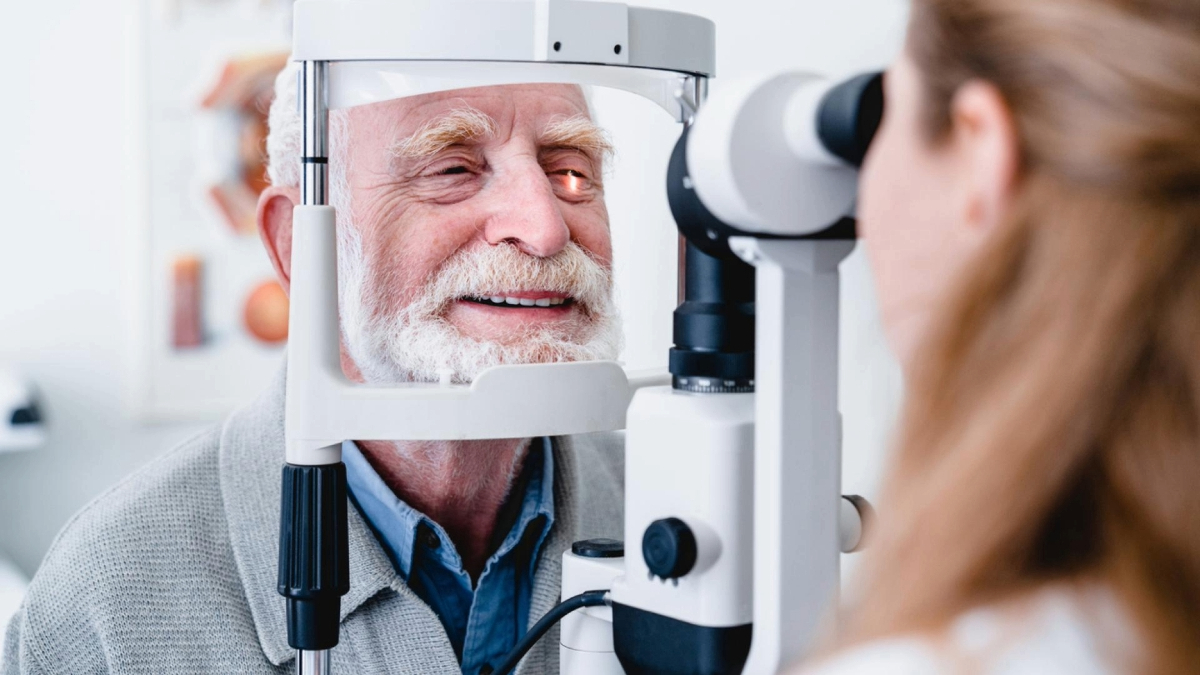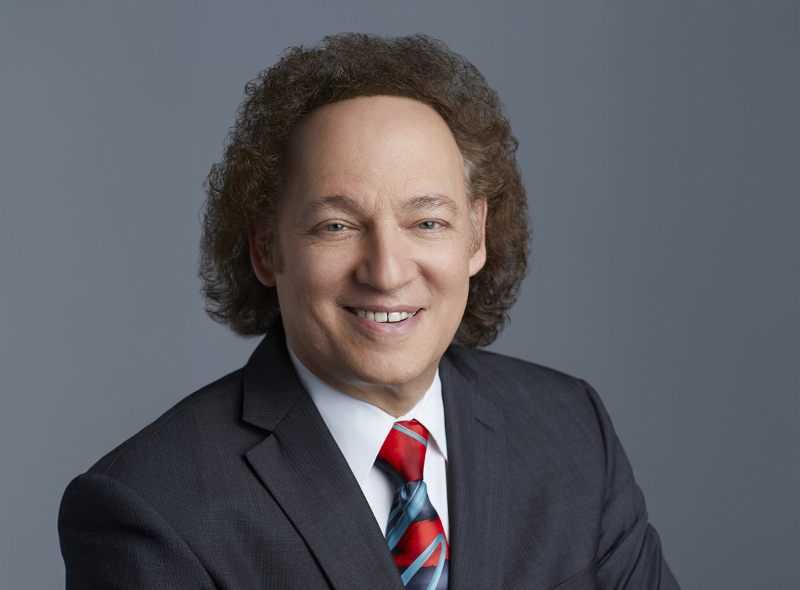Promising New Treatments for Age-Related Macular Degeneration
Featuring
Joshua Dunaief, MD, PhD
University of Pennsylvania Perelman School of Medicine





Joshua Dunaief, MD, PhD
University of Pennsylvania Perelman School of Medicine

The telephone discussion features Dr. Joshua Dunaief, of the University of Pennsylvania’s Perelman School of Medicine, who specializes in the study of age-related macular degeneration.
* UPDATE: In October of 2019, the FDA approved Beovu® (brolucizumab). Learn more about this treatment.
BrightFocus Foundation
Promising New Treatments for AMD
April 26, 2017
Transcript of Teleconference with Joshua Dunaief, MD, PhD
12:00–1:00 p.m. EDT
The information provided in this transcription is a public service of BrightFocus Foundation and is not intended to constitute medical advice. Please consult your physician for personalized medical, dietary, and/or exercise advice. Any medications or supplements should be taken only under medical supervision. BrightFocus Foundation does not endorse any medical products or therapies.
Please note: This Chat has been edited for clarity and brevity.
MICHAEL BUCKLEY: Hello, I am Michael Buckley from BrightFocus Foundation. Welcome to today’s BrightFocus Chat, “Promising New Treatments for Age-Related Macular Degeneration (AMD).” If today is your first time on a BrightFocus Chat, let me take a moment to tell you a little bit about BrightFocus and what we will do on today’s Chat. BrightFocus funds some of the top scientists in the world. We support scientists around the globe who are trying to find cures for macular degeneration, glaucoma, and Alzheimer’s. We share the latest news from these scientists with families that have been impacted by these diseases. BrightFocus Chats are another way of sharing this information.
We are thrilled to have a returning guest with us today, Joshua Dunaief. He is the Adele Niessen Professor of Ophthalmology at the Scheie Eye Institute at the University of Pennsylvania. You may recognize his name—he has written several articles on our website and has appeared on several of our Chats before. Today’s topic, “Promising New Treatments for AMD,” may get a little complicated in some areas when we mention names of treatments. Dr. Dunaief and I will do the best we can to speak slowly and clearly. Dr. Dunaief, thank you so much for joining us today.
DR. DUNAIEF: Hi, Michael, good to be with you.
MICHAEL BUCKLEY: Dr. Dunaief, why don’t we start with your general sense about the state of promising new treatments for AMD?
DR. DUNAIEF: Michael, it is an exciting time. We know, and patients with wet AMD know, that there have been great strides made in treatment of wet AMD in the form of Lucentis®, Eylea®, and Avastin®.* About 10 years ago, if a patient got wet AMD they would often lose their central vision. Now, with the advent of these drugs, patients often keep their central vision. Of course, the big hassle is that many patients need to have injections every month or two, and that is really a huge burden on patients and their families. One of the most exciting things right now is the possibility of developing some longer lasting drugs that can be injected into the eye and last perhaps 3–6 months. There are a couple of ways that researchers are approaching trying to develop these drugs.
MICHAEL BUCKLEY: Related to that, I would like to mention a few names of those drugs and have you comment a bit on their potential for treating dry AMD and when they might be available to the public. I would like to know your thoughts on the drug lampalizumab.
DR. DUNAIEF: Lampalizumab is, like a number of drugs that are being used now, similar to an antibody. Fortunately, when antibodies are injected into the eye, it is found that this can be quite helpful and therapeutic and last for a month or two. Lampalizumab is a drug that targets an advanced dry form of AMD called geographic atrophy, and it is currently in advanced Phase III clinical trials. The drug is injected into the eye once a month, where patients are being followed. The primary endpoint of the study is going to be at 1 year. The goal is to try to slow the expansion of the atrophy or stop it completely.
Patients with geographic atrophy have a patch of essentially dead vision cells somewhere near the center of the retina, and over time the patch tends to expand, which enlarges the central blind spot. The goal in patients with geographic atrophy is to stop or slow the expansion of that blind spot, and in Phase II trials lampalizumab did seem to slow the progression of the size of the atrophy.
It only works well in patients with a particular genetic makeup: The company that did this trial looked at the sequence of a couple of genes related to lampalizumab. One is called Complement Factor I; in patients who had a certain DNA sequence for Complement Factor I, lampalizumab slowed the progression of atrophy by more than 40 percent, which really is a great response that should translate to visually significant response.
The question now is, in large Phase III trials, will this early result hold up and will the treatment still appear safe and effective when used in more than 1,000 patients in these clinical trials? For patients with geographic atrophy, I think there is some pretty good hope on the horizon with this clinical trial.
MICHAEL BUCKLEY: That is great, thank you so much. I know you briefly mentioned Lucentis® in your opening remarks. Would you tell our listeners about a possibility of a sustained delivery of Lucentis®?
DR. DUNAIEF: Yes. Genentech—the maker of both Lucentis® and lampalizumab—is doing a trial with a device, which is about the size of a grain of rice, that can be implanted into the eye and stays flush with the eye wall. Most of it is inside the eye, but a small portion is flush with the eye wall. It is implanted in the operating room and it takes about 15 minutes to implant the device, which is filled with Lucentis®. It is a sustained release system, so it slowly releases the Lucentis® into the eye, which extends the time period during which the Lucentis® is at therapeutic concentrations in the eye.
At Phase I trial, it looked like this device could continue to release the drug in the eye for about 4 months. What this means is that patients would just need to come back and get their device refilled possibly only every 4–6 months. The way the device is refilled is very similar to the way injections are currently given. The big difference is that the refilling would only happen every 4–6 months rather than every month.
MICHAEL BUCKLEY: Wow. I appreciate that. It seems like it has the potential to be very helpful. A few more medications, Dr. Dunaief, I want to ask for your updates. Another would be Zimura.
DR. DUNAIEF: Let’s get back to Zimura. I actually wanted to talk for just another second about the Lucentis® device. Probably people are wondering when this might become available for them. Currently, it is in a Phase II clinical trial, which has been fast-tracked by the U.S. Food and Drug Administration (FDA). So, that could mean that it will be approved more rapidly than it would otherwise. When will this actually become available? I would say probably within about 2 years for the general public, if all goes well with the clinical trials.
MICHAEL BUCKLEY: Well, great. I appreciate that, it’s very helpful. Did you want to discuss Zimura now, or did you want to elaborate a little more on Lucentis®?
DR. DUNAIEF: Let’s go to lipoic acid now. Lipoic acid is an antioxidant that’s being tested at five clinical sites, including at the University of Pennsylvania, which is my institution. It is being tested in geographic atrophy patients. So, patients are taking the lipoic acid pill once a day and seeing—similar to the lampalizumab trial—whether this pill can slow the progression of the atrophy. This trial is much smaller than the lampalizumab trial, but it is still enrolling patients, and I think we should get the results in about 1 to 2 years.
Another drug I wanted to mention is abicipar. Abicipar is also an anti-vascular endothelial growth factor (anti-VEGF) drug, like Lucentis®, Eylea®, and Avastin®, but its structure is a little bit different and that enables it to last in the eye a bit longer. Abicipar, in theory, could be injected only every 3 months. That would be just a standard injection. It wouldn’t need to be injected into any particular type of device, just injected right into the eye. Abicipar is now in Phase III trials. I think the results are expected in 2018.
MICHAEL BUCKLEY: Great! Any others you would like to discuss?
DR. DUNAIEF: Well, people often ask about Fovista®. Fovista® is a drug with a different target from VEGF. It is called PDGF, or platelet-derived growth factor. It is known that platelet-derived growth factor plays a role in the growth of abnormal blood vessels in the eye, which is a problem in wet macular degeneration. Abnormal blood vessels can leak and bleed.
Two different drugs have tried to target PDGF in combination with anti-VEGF drugs like Lucentis®. One is called Fovista®, and the other is called rinucumab. Unfortunately, very recently, both of them were found to be ineffective in clinical trials. There was a lot of excitement about Fovista®, because it looked like it was effective in a Phase II smaller clinical trial, but once it got to a large Phase III clinical trial, it was shown that it did not add any benefit compared to Lucentis® alone. So that was a big disappointment. It’s not infrequent that drugs that look promising in small Phase II clinical trials actually don’t do well in Phase III trials. That is why it is important to do the Phase III trial before releasing the drug to the public.
MICHAEL BUCKLEY: We’ve actually have a few questions from callers about clinical trials. How does someone get involved in a clinical trial for vision disease?
DR. DUNAIEF: Good question. The patient’s physician is in a good position to determine whether the patient might be eligible for a clinical trial. The patient’s ophthalmologist or retina specialist, in the case of macular degeneration, would know about clinical trials. For a patient who asks about them and expresses interest in joining one, the physician can look at all of the criteria for the clinical trial. Each trial has inclusion and exclusion criteria. They are looking for a specific kind of patient in a specific stage of their disease. If an interested patient meets the criteria for a particular study, then the physician can refer the patient to the investigators who are doing the study.
Studies are often coordinated by academic centers. They may also include private practice groups. Patients should be very aware of who is sponsoring the clinical trial and make sure that it is really a legitimate clinical trial. One thing that they should know is that they really should not have to pay for treatment within a clinical trial. If patients are being asked to pay thousands of dollars to participate in the clinical trial, it is very unlikely to be a legitimate clinical trial. There are a couple of examples recently where patients had disastrous results when they were given so-called “stem cell” injections at a private clinic. The patients seemed to think they were participating in a clinical trial, they did pay thousands of dollars, and then they had horrible inflammation in their eyes that caused them to lose a lot of vision.
MICHAEL BUCKLEY: Oh my. It sounds like your advice is to really have that conversation one-on-one with your physician. To support that conversation, I want to remind our listeners that late last year we put out a publication called Clinical Trials: Your Questions Answered. That is available free of charge on our website, BrightFocus.org. Speaking of clinical trials, we have a question from Mark from New York. He has been doing a bit of research about clinical trials on different websites. He is wondering if you could talk a bit about why a diabetes drug has the possibility to help macular degeneration.
DR. DUNAIEF: There is now a clinical trial with a diabetes drug called metformin. Metformin has some antioxidant activities that suggest that it may be helpful in macular degeneration. Macular degeneration involves oxidative damage, which is free radicals reacting with our own proteins and lipids in the retina. Over time, this causes irreparable damage to those molecules and DNA mutations.
Antioxidants have, for a long time, been proposed as a potential treatment for macular degeneration. Several large clinical trials showed that certain antioxidants can actually slow the progression of macular degeneration. That trial was called the Age-Related Eye Disease Study, or AREDS. Now, many patients will be familiar with AREDS, because they are taking AREDS vitamins. These vitamins are a combination of antioxidants that are given to people with drusen. Drusen are the little white spots in the retina that ophthalmologists can see when they do an exam or take pictures of the retina. For patients who have a certain number and size of drusen, they’ve shown that the risk of progression to advanced macular degeneration is significantly reduced if the patient takes those AREDS vitamins.
Metformin is along the same lines as an antioxidant. In theory, it might work better than AREDS vitamins or in combination with AREDS vitamins. It might provide better protection, but we will see what happens with the clinical trial.
MICHAEL BUCKLEY: Well great, thank you. We are getting several more questions that I want to share with you. Phyllis from New Jersey is referencing the lipoic acid comments you referenced earlier. She said she has seen these sold over the counter in a vitamin store. How does that relate to what is being studied in the clinical trial right now?
DR. DUNAIEF: Great question, Phyllis. Lipoic acid is indeed available in pharmacies and vitamin stores. I would not recommend that people take it for macular degeneration outside of the clinical trial. The reason is that it has not been tested yet and certain things that theoretically seem like they should be helpful actually wind up being useless or, in some cases, even harmful. So it is important for patients to participate in clinical trials. Some patients will be reluctant because they know they have about a 50/50 chance of being given a placebo. That is the only way we can find out if the drugs are safe and effective. If you do participate in a clinical trial, within a couple of years you’ll have helped to find out whether or not the drug is actually effective, and that will help everybody. It will help the patients in the clinical trials to know that they should be taking that drug and it will help everybody else who will now know that they should be taking it if they have certain forms of macular degeneration.
MICHAEL BUCKLEY: I appreciate those comments. I think it pulls back the curtain about how science works and how new treatments reach the marketplace. We’ve had three or four questions in the last few minutes about stem cells. It’s a big, broad topic, but could you talk a bit about that? What’s new there in terms of macular degeneration?
DR. DUNAIEF: Yes, certainly. I think the most exciting development in stem cells now are the way they can be made. It is now possible to take a patient’s own skin cells or blood cells and add a few genes to them to reprogram them into retinal cells. It really is a remarkable thing. These retinal cells in plastic dishes can look very similar to the retinal cells that we have in the eye. There have been a few clinical trials looking at whether implanting these retinal cells is safe. Several of them have suggested that it can be safe, although again, I have to emphasize that if you are interested in participating in a stem cell trial make sure that it is a legitimate clinical trial that you don’t have to pay for, because this disastrous trial that happened at a clinic was not a well-controlled clinical trial.
Legitimate trials where the stem cells are implanted—they are typically grown on a scaffold that is then unrolled under the retina where the cells can take up residence in the appropriate layer of the retina and provide nourishment and support in the retina. The stems cells that I think have the most potential are called retinal pigment epithelial cells, or RPE cells. The reason I like those is because they are not neurons, so they don’t need to make neuronal connections in order to be functional. The challenge with implanting neuronal stem cells like photoreceptors is that those cells have to establish functional connections between axons and dendrites in order to help improve vision. Those types of connections are made meticulously during the development of the eye. Once an eye is mature in an adult, it is very difficult to ask a stem cell to make the appropriate connections with the existing resident cells in order to restore vision. That has been done on a small scale in a couple of experimental systems with mice, for example, but the efficiency of these connections is very low. At least for now, the RPE stem cells hold more promise for the short term.
MICHAEL BUCKLEY: Similar to our discussion of clinical trials, I think stems cells are a topic that everybody recognizes but perhaps doesn’t know that much about. Thanks for shedding light on that. We have time for maybe one or two more questions. Dr. Dunaief, Mary from Texas is asking, “Are lasers being studied to treat the advanced form of dry macular?” That’s geographic atrophy.
DR. DUNAIEF: Lasers were used commonly for wet macular degeneration back before we had anti-VEGF drugs. There are a couple of different kinds of lasers that were used. One is called photodynamic therapy. That was used in combination with a medicine that was given intravenously, and then patients had to stay out of the sunlight for 5 days. Some of you listeners may remember receiving that. That worked okay, but not as well as the anti-VEGF drugs.
For the vast majority of patients with wet macular degeneration, they are getting anti-VEGF injections like Lucentis®, Eylea®, and Avastin® and not getting any kind of laser treatment anymore. There was a clinical trial to look at patients with dry macular degeneration to see if lasers could make their drusen go away. A very low-energy laser. Actually, it did promote this disappearance of some of the drusen, but unfortunately did not result in better outcomes in terms of vision. There isn’t currently any recommended laser treatment for dry macular degeneration at the early form or for the geographic atrophy form. There are a few clinical trials that are ongoing to look at whether different types of lasers might be beneficial, but nothing is currently recommended or approved to be effective.
MICHAEL BUCKLEY: Thanks. Just to remind our listeners, as I said at the onset, BrightFocus funds research all around the world on many of the topics that we discussed today, and whenever there are new developments from the field of research we put them on our website as soon as we can. Dr. Dunaief, I would like to conclude, if you wouldn’t mind. You’ve had a lot of experience in the lab and the clinic. Do you have any big-picture advice to give to patients or a big-picture perspective to give to our listeners that they may find useful?
DR. DUNAIEF: Yes, definitely, Michael. Many patients, when they would first come to me, would be really terrified. They would be told that they have macular degeneration and would be terrified that they would go blind. I really like to reassure patients that that is not likely to happen. First of all, patients with early macular degeneration just have these little white spots in the retina called drusen, which are detected by an ophthalmologist or an optometrist, and they may not even have any vision loss. Those patients, if they have a healthy lifestyle and take AREDS vitamins—if their doctor recommends it—still have a good chance of not losing any central vision. What I mean by healthy lifestyle is not smoking, eating a diet that is rich in fruits and vegetables, having fatty fish twice a week—meaning salmon, sardines, tuna, or mackerel—wearing sunglasses when out in bright light, exercising, keeping an eye on your weight, and monitoring your vision at home with a graph called an Amsler grid. You look at this with one eye at a time with your reading glasses on. If you see missing or wavy lines, that can be an indication that you’ve developed some wet macular degeneration.
Back 10 years ago, if people got wet macular degeneration, they were likely to lose a lot of central vision. Now that we have these Lucentis®, and Avastin®, and Eylea® injections available, a lot of patients with wet macular degeneration still keep pretty good central vision because of those treatments. For patients who get geographic atrophy, the atrophy is likely to expand, but expand slowly over the course of a number of years and, as we discussed before, lampalizumab has a pretty good chance of slowing the growth of that atrophy. We will see within a couple of years whether that could be useful for people with geographic atrophy.
The bottom line is that the majority of patients who come in with drusen are not going to lose their central vision these days. Even in the worst case, if they do lose the central vision in both eyes, it’s just the central vision that is affected. Macular degeneration is called macular degeneration because it affects only the macula, which is the very central part of the retina. So, [it affects] the part that we need for good reading and driving vision, but the whole peripheral retina is usually unaffected. Patients are usually still able to use that peripheral vision quite usefully to read very slowly with the help of magnifiers and closer televisions to navigate around. It is extremely unusual for macular degeneration to become total—no light perception, can’t see any light at all—just from macular degeneration. I think it is important that people have that perspective, and that the outlook for any patient coming in with drusen is pretty positive.
MICHAEL BUCKLEY: I appreciate that. It’s good perspective and is encouraging. I really think today has been a great opportunity to hear from someone on the frontlines of macular degeneration research, and there are definitely some encouraging signs for the future. To our listeners, a minute ago Dr. Dunaief mentioned something called an Amsler grid. Those are available free of charge from BrightFocus. It comes in the form of a magnet, and many folks keep it on their refrigerator to do that self-check that Dr. Dunaief mentioned a minute ago.
Dr. Dunaief, on behalf of everyone at BrightFocus and our listeners, I want to thank you for being so generous with your time and being so helpful and sharing a lot of good information.
DR. DUNAIEF: My pleasure, Michael.
MICHAEL BUCKLEY: Alright. Thank you. This concludes today’s BrightFocus Chat.
BrightFocus Foundation is a premier global nonprofit funder of research to defeat Alzheimer’s, macular degeneration, and glaucoma. Through its flagship research programs — Alzheimer’s Disease Research, Macular Degeneration Research, and National Glaucoma Research— the Foundation has awarded nearly $300 million in groundbreaking research funding over the past 51 years and shares the latest research findings, expert information, and resources to empower the millions impacted by these devastating diseases. Learn more at brightfocus.org.
Disclaimer: The information provided here is a public service of BrightFocus Foundation and is not intended to constitute medical advice. Please consult your physician for personalized medical, dietary, and/or exercise advice. Any medications or supplements should only be taken under medical supervision. BrightFocus Foundation does not endorse any medical products or therapies.

Join us for a special discussion on clinical trials for macular degeneration.

Join us for a conversation about light therapy and macular degeneration, where we’ll explore how different types of light—blue, red, and sunlight—affect the retina, the science behind light therapy, and the newly approved Valeda red light therapy

Learn about how to navigate treatment options, engage in shared decision-making with your healthcare team, and maximize your eye health.

Join us for an in-depth discussion on the latest developments in wet age-related macular degeneration treatment.
